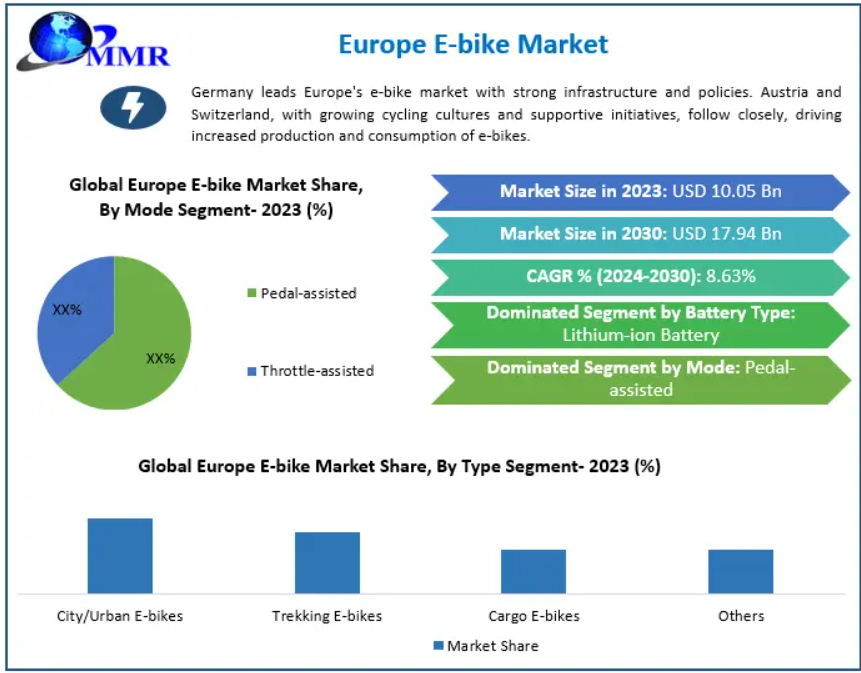Europe E-bike Market to Reach USD 17.94 Bn by 2030, Fueled by Urban Mobility and Green Transport Shift
The Europe E-bike Market, valued at USD 10.05 billion in 2023, is projected to grow at a robust CAGR of 8.63% during 2024–2030, reaching nearly USD 17.94 billion by 2030. The surge is being driven by Europe’s strong emphasis on sustainability, government incentives, and the rapid adoption of eco-friendly urban transport solutions.
To know the most attractive segments, click here for a free sample of the report: https://www.maximizemarketresearch.com/request-sample/21420/
Market Overview
An electric bicycle, or e-bike, integrates a battery-powered motor to support pedaling or throttle-assisted movement. With rechargeable lithium-ion batteries, advanced control systems, and compact motors, e-bikes allow riders to travel longer distances with less effort while reducing dependency on fossil fuels. Their growing popularity among urban commuters, recreational cyclists, and adventure riders underscores their role as a sustainable alternative to cars and motorcycles.
The European Union’s policies to cut emissions, coupled with investments in cycling infrastructure, have made e-bikes an integral part of urban mobility strategies. Forecasts suggest that by 2025, annual e-bike sales in Europe could reach 10 million units, outpacing the growth of electric cars and reshaping the continent’s mobility landscape.
Market Dynamics
Growth Drivers
- R&D and Innovation: European bicycle manufacturers are heavily investing in electric assistance systems across multiple segments, including road, mountain, trekking, and cargo bikes. Cargo e-bikes, in particular, are emerging as substitutes for cars among families, supported by subsidies.
- Government Incentives: Subsidy schemes, tax deductions, and leasing programs across Germany, the Netherlands, and Belgium are accelerating adoption.
- Consumer Shift: Rising fuel costs, congestion, and environmental awareness are pushing commuters toward affordable and green transportation modes.
Challenges
- High Upfront Costs: Prices for e-bikes, averaging around €2,800 in Germany, remain a barrier for price-sensitive consumers.
- Battery & Component Supply Constraints: Shortages of batteries and electronic drive systems have restricted production capacity in recent years, with companies like Bosch facing supply chain bottlenecks.
- Regulatory Fragmentation: Inconsistent licensing requirements and infrastructure policies across EU nations create hurdles for standardization and cross-border trade.
- Range Anxiety: Concerns about battery durability and charging infrastructure continue to deter some potential buyers.
Segment Analysis
- By Battery Type: Lithium-ion batteries dominate, thanks to their high energy density, long life cycle, lightweight properties, and fast-charging capabilities. This segment is expected to expand at a CAGR of 8.64% through 2030.
- By Class: Class 1 e-bikes (pedal-assist, max speed 20 mph / 32 km/h) lead the market. Their compliance with EU regulations and compatibility with existing cycling infrastructure make them the most accepted category.
- By Usage: Urban/city e-bikes hold the largest share, but cargo and trekking e-bikes are witnessing the fastest growth, driven by lifestyle changes and logistics needs.
To know the most attractive segments, click here for a free sample of the report: https://www.maximizemarketresearch.com/request-sample/21420/
Regional Insights
- Germany: The largest e-bike market in Europe, with sales reaching 2.2 million units in 2022—accounting for nearly 48% of total bicycle sales. Revenue from bicycles in Germany alone hit €7.36 billion, largely driven by e-bike adoption.
- Netherlands & Belgium: The Netherlands leads in ownership, with 30% of households owning an e-bike and over 50% of total bicycle sales attributed to e-bikes. Belgium surpassed the halfway mark even earlier, in 2019.
- Austria & Switzerland: Both nations report e-bikes accounting for 34–41% of total bicycle sales, making them significant contributors to regional growth.
- UK & France: Experiencing rapid adoption, particularly in urban areas, with commuters seeking practical alternatives to cars and public transport.
Competitive Landscape
The Europe E-bike market is highly competitive and innovation-driven, with established manufacturers and emerging startups focusing on design, battery performance, and connectivity features. Key players include:
- Accell Group (The Netherlands)
- Kalkhoff Works GmbH (Germany)
- Haibike (Germany)
- Royal Dutch Gazelle (The Netherlands)
- Riese & Müller (Germany)
- VanMoof (Netherlands/Germany)
- Bianchi (Italy)
- Moustache (France)
- Brompton & Gocycle (UK)
These players are leveraging R&D, expanding distribution networks, and launching leasing/subscription models to expand market reach.
Future Outlook
The Europe E-bike market is set for strong momentum, shaped by:
- Electrification of mobility: With EU’s emission targets, e-bikes are becoming central to sustainable transportation policies.
- Smart e-bikes: Integration of GPS, IoT, and connected apps will enhance rider safety, navigation, and theft prevention.
- Cargo and Utility E-bikes: Growing demand for last-mile delivery and family commuting is expected to fuel growth in the cargo segment.
- Mass adoption: Falling battery prices and economies of scale are likely to make e-bikes more affordable, accelerating their adoption across all income segments.
By 2030, e-bikes are expected to play a mainstream role in Europe’s transport ecosystem, transforming both personal mobility and urban logistics while delivering environmental and economic benefits.
